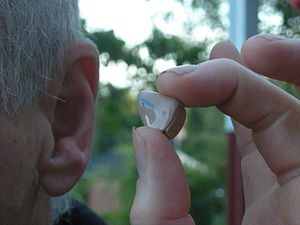
?esky: Naslouchadlo – instalace do ucha English: Hearing aid, photo taken in Sweden (Photo credit: Wikipedia)
(ARA) – When it comes to our health, many Americans have two realities: what we know and what we think we know. When what we think we know is less than accurate, it can be as harmful to our health as the things we don’t know at all. Perceptions about hearing loss are a good example of this phenomenon.
You may think you already know a lot about hearing loss and treatment, but some of the facts surrounding this prevalent problem – for instance that, according to the Better Hearing Institute (BHI), 11 percent of Americans report having hearing difficulties – could surprise you. Here are some realities that may make you reconsider what you think you know about your hearing, what puts it at risk and what you can do if you suffer a hearing loss:
Surprising fact No.1 – Not everyone who has hearing loss is old. In fact, most people with hearing problems (65 percent) are younger than 65, BHI reports. And, more children and teenagers are experiencing hearing loss. Nearly one in five American teens now has some level of hearing loss, according to a 2010 study by researchers at Brigham and Women’s Hospital in Boston.
While you may think the volume dial on Johnny’s iPod is directly related to his hearing problems, there’s more to the story, researchers say. Which leads to the next fact.
Surprising fact No. 2 – Threats to our hearing lurk in places you might not expect. Protecting your ears while engaging in activities you know are loud – such as attending a rock concert or a visiting a shooting range – is only the start. Gradual hearing damage can begin to occur with prolonged exposure to sounds of just 85 decibels-roughly the volume generated by a kitchen blender.
So while that MP3 player may be a contributing factor to a child’s hearing loss, it’s not the only one. In fact, very loud toys -those that emit 90 decibels or more – can be a risk factor, too, according to the American Speech-Language-Hearing Association. Hearing experts take the toy risk so seriously, that every November the Sight and Hearing Association publishes a list of the noisiest toys.
Surprising fact No. 3 – Loud noise isn’t the only thing that can damage hearing. In reality, many outside factors – from some medications to a blow to the head – can cause hearing loss. Pressure differences between the inside and outside of the eardrum can be harmful, putting SCUBA divers and frequent flyers at risk.
Diseases like sickle cell anemia, kidney disease, toxoplasmosis and even herpes have been linked to hearing loss. Chemotherapy drugs, loop diuretics and some antibiotics also can affect your hearing. Even large quantities of aspirin (salicylates) may cause hearing loss.
Surprising fact No. 4 – Hearing loss not only affects your ability to hear and your quality of life, it may even hurt your earning potential. The BHI reports that untreated hearing loss may decrease your income by up to $30,000 a year. The good news is that treating hearing loss with hearing aids can reduce the risk to your income by 90 to 100 percent if your hearing loss is mild, and from 65 to 77 percent if it’s moderate to severe. Which leads to fact five.
Surprising fact No. 5 – Hearing aids change lives. Technology has made modern hearing aids more effective, versatile, convenient and discreet than ever before. Advances like completely-in-canal styles make it virtually impossible for observers to know if someone is wearing a hearing aid.
Wireless hearing aids, such as those marketed by Starkey Hearing Technologies, can even stream sound directly from your TV, MP3 player or radio to your hearing aids, all without a relay device. The aids automatically transition from one device to another when you move from room to room. And the Starkey Hearing Technologies wireless hearing aids come in three custom styles including completely-in-canal (CIC), in-the-canal (ITC) and in-the-ear (ITE).
Surprising fact No. 6 – Despite the prevalence of hearing loss, less than 15 percent of American adults who get a physical exam this year will also have their hearing screened by their physician or nurse during that exam, a BHI survey indicates.
“The vast majority of doctors in today’s health care system don’t include hearing health as a routine part of annual exams, despite the fact that more than 95 percent of those with hearing loss could benefit from hearing aids,” Dr. Sergei Kochkin, executive director of BHI, said in a press release announcing the survey.
Related articles
- Hearing Aids Improve Quality of Life, Empower People with Hearing Loss to Stay Socially Active, New Study by Better Hearing Institute Finds (prweb.com)
- When Shingles Leads to Hearing Loss (everydayhealth.com)
- What questions should you ask before buying a hearing aid? (moneysavingreviews.com)


